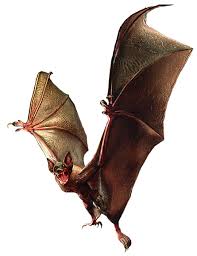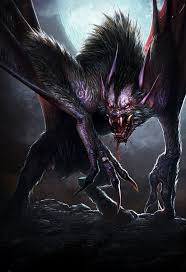Giant Bat
The giant cousins of the common bat, known as Giant or Dire Bats, are nocturnal hunters far deadlier than their smaller, more mundane cousins.
Appearance
Bats are furry mammals that resemble rodents (though they are not related). Their wings are actually highly modified forelimbs with leathery skin stretched between elongated fingers. Most bats have large ears and sharp pointed teeth to help them hunt. Giant bats resemble their smaller cousins grown to massive proportions. Their wingspans can reach almost 15 feet, and they can weigh more than 100 pounds.Giant or Dire Bats
Giant bats are nocturnal creatures who prefer to lair in remote caves or similarly isolated, sheltered locations where they can sleep away the day and emerge to hunt at night. Not all giant bats hunt beneath the night skies. Unlike their smaller cousins, who can live in colonies of thousands, giant bats tend to be solitary or in groups of no more than eight adults. Despite their fearsome appearance, most eat fruit or insects, and fight only out of hunger or fear.As mounts
Some smaller humanoid creatures have tamed and ridden giant bats as mounts, especially in underground or mountainous regions.Basic Information
Anatomy
Beast (Giant), Bat: Bats are furry mammals that resemble rodents (though they are not related). Their wings are actually highly modified forelimbs with leathery skin stretched between elongated fingers. Most bats have large ears and sharp pointed teeth to help them hunt.
Ecology and Habitats
Bats of all sizes are usually active at night and are among the few mammals capable of powered flight. Most bats have only average eyesight honed for places with little light, but use echolocation to "see" with their ears.
Common bats eat insects or fruits, and can be found in caves, ruins, or even city sewers. Though harmless on their own, they sometimes gather in huge swarms that can overwhelm larger creatures. These tiny animals are often chosen as familiars by wizards.
Dietary Needs and Habits
Many bats are insectivores (Insect-eaters), and most of the rest are frugivores (fruit-eaters) or nectarivores (nectar-eaters). A few species feed on animals other than insects; for example, the vampire bats feed on blood.
Additional Information
Social Structure
Colonies of 12 to 20 or Solitary
Domestication
Goblins, Kobolds and some Orcs use these creatures as flying mounts.
Uses, Products & Exploitation
- Guano
- Fur/Skin
- Meat
- Teeth and Claws
Perception and Sensory Capabilities
- Blindsight 60ft, and
- Passive Perception 11
Origin/Ancestry
Beast (Bat)
Lifespan
60 years to 150 years old (Averaging 100 years)
Average Weight
Giant Bats can weigh more than 100lbs, The largest being 300lbs to 400lbs
Average Length
They can have Wingspans up to 15 feet




Comments
Author's Notes
Original Article on Pathfinder Wiki.